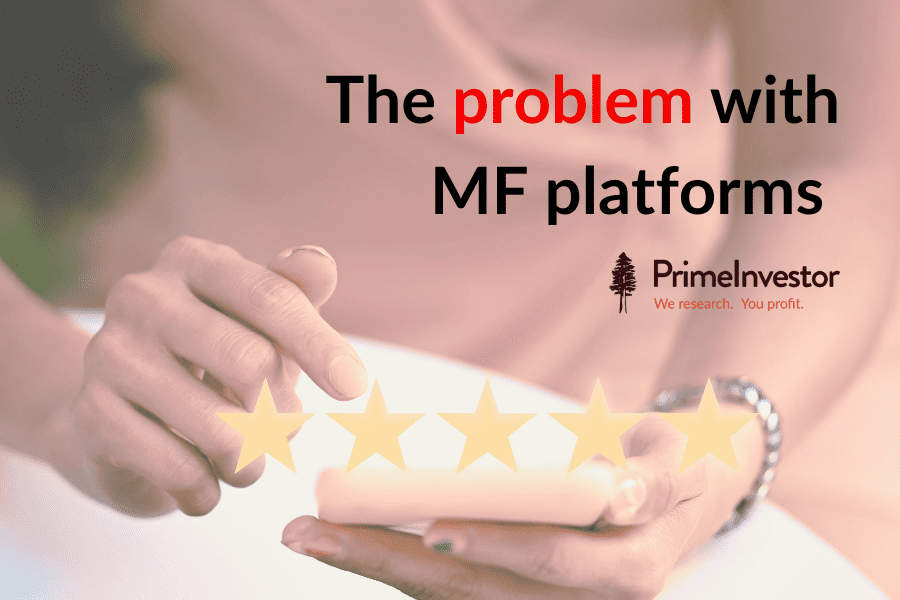Mutual fund investors in India are spoilt for choice when it comes to MF platforms. There are those that offer direct plans and those offering regular plans. Those with demat and those without. There are barebones platforms and ‘value-added’ platforms. They solve a single problem for the mutual fund investors in the country – digitally executing a mutual fund transaction with ease and comfort.
But as a recent article in The Ken points out, the problem with these platforms is that they do a really poor job of telling their customers how to invest and where to invest – how to choose the good funds for them from the hundreds available. Besides, they sometimes end up giving dangerously wrong cues, highlighting the recent top-returning funds that can well become the laggards soon.

True enough. Most of these platforms rely on, as the article points out, some variant of a ratings system and lets the customer gravitate towards ‘five-star’ funds (who would choose anything lesser??) And there are problems aplenty with such an approach.
But The Ken article doesn’t really provide an end-solution for the investor – a solution that is cost effective and free of mis-selling. In fact, it almost appears to suggest that there is no solution for those using new age platforms, especially to invest in direct plans (which are cost saving).
But we at PrimeInvestor have a solution and a very clear one to overcome the limitations of your execution platforms! And that’s PrimeInvestor itself 😊
Before we get there, let’s first explain what a mutual fund rating represents, how to incorporate fund ratings into your investment decision – and how to get past the problems of relying on ratings.
How are mutual funds rated
At PrimeInvestor, we are fully aware of the several problems with ratings system and have been aware of for years now even as we developed our own ratings system. If that’s the case, why do we have ratings and how do those problems get solved?
To understand what a fund rating represents and how to look at it, it’s important to first know how a rating is arrived at. Any mutual fund rating system will consider different return aspects. Now, obviously, we can explain only how we rate funds:
- A gating criteria to remove funds with short track records or small AUM – this depends on the fund category. This eliminates problems of very recent performance influencing ratings and avoids rating tiny funds where risks are higher (due to sudden influx or exodus of money).
- Different return periods and different metrics to measure returns. For example, fund categories meant for longer periods use longer term returns and have consistency in performance as a key metric. This again eliminates risks of recent returns influencing ratings.
- Portfolio data to measure risks. This includes credit risks, risk in small-and-midcap exposure, risks in unhedged portfolios in hybrid funds, portfolio maturity, and so on. This helps identify and factor in risks to balance risk and return in ratings.
- Different metrics with different weights for each category, based on the characteristics of that category and what is important for it. For example, the metrics we use in large-cap funds are different from multi-cap funds. Metrics for short duration funds are very different from dynamic bond funds or gilt funds. This approach makes the ratings far more representative of returns & risks of each category.
So, even if we say it ourselves, Prime Ratings are extremely comprehensive and balanced. But there are still two aspects to it that subject ratings to the problems highlighted by The Ken.
- One, ratings are fully quantitative based on past performance and portfolios. It is not predictive and is not qualitative to measure fund strategy or portfolio quality.
- Two, a fund’s rating is relative to other funds in its category. A high rating merely means a fund is better than peers. It might be possible that an entire category is doing poorly and you still have high-rated funds in that category! Bear these in mind, and let’s move to the limitations in ratings.
The limitations in mutual fund ratings
This section can also be titled ‘Why you shouldn’t rely on ratings’. It’s why we clearly declare in Prime Ratings that a rating is not a recommendation to buy, hold, or sell a fund.
#1 Why ratings can be misleading
As the Ken article points out, many platforms showcase ‘Top-rated funds’ or ‘High return funds’, shining the spotlight on current performers. This does not take into account a fund’s suitability for you or your portfolio, and therefore the ratings can mask the real risk that you may be taking on or prompt you to invest in funds that do not fit your requirements.
A fund receives a rating based on where it stands compared to other funds in its category. If the category itself is not doing well, you will still have a 5-star fund – just that it would be the best of the worst, so to speak. Here’s an example. Most large-and-midcap funds have been struggling to beat the Nifty LargeMid 250 index with any consistency. Therefore, a fund can have a 4.5 star rating simply because it’s better than others in its category, but is still fundamentally not a good performer!
Similarly, take thematic funds. Giving a 5-star rating to a banking fund does not mean it’s a good buy at all times! When the cycle for a particular theme or sector is down, you can have a top-rated fund but performance itself can be sub-par. (We don’t rate thematic funds in Prime Ratings for this reason, but some other ratings agencies do)
Many rating methodologies also find it hard to capture portfolio risks or category-level until the risk actually materialises and impacts returns. Take credit risk in debt funds. Many hold low-rated papers where high yields lift fund returns, pushing up the rating. All metrics that use return – rolling returns, average returns, Sharpe, volatility – will look rosy, until the time a credit event transpires!
#2 Ratings don’t show fund style
There are different styles that funds adopt. Equity fund investment styles can be growth-based, focused, value-based, blended growth and value, or go-anywhere funds. Some take cash calls, some get more aggressive. Debt funds strategies can be duration-based, accrual, or credit. Hybrid funds can also have different ways of managing markets.
Funds in the same category can be high-rated but can have similar or very different strategies. A fund could be excellent at delivering well during market rallies, another could excel at containing downsides – both could well fit a portfolio.
A fund rating does not show this qualitative aspect to a fund’s performance and how it can fit in a portfolio. It only captures the outcome of the fund style.
For example, SBI Smallcap can take cash calls in its portfolio and this characteristic has brought down recent returns and therefore its Prime rating. Other smallcap funds do not, and have captured more of the market rally. SBI’s conservative approach may well turn out to be a good move compared to top-rated funds now if the market tanks.
Essentially, the differences in strategies that have a say in returns cannot be captured in any quantitative manner.
#3 Fund ratings don’t capture turnarounds
First, it needs to be understood that no fund rating can remain the same. Unlike credit ratings of debt papers (where they are rated for their own strengths and limitations) MF ratings are relative to peers. That means they will change as no fund can capture the crown for a lifetime! So, when The Ken talks of ratings of funds changing significantly in 3-4 years, the argument is not sound. It is bound to change with newer performers and even sudden outlier performance (like Quant funds for a couple of years) by some funds. Such outliers will naturally push down the ratings of even the steady performers. This does mean the latter funds are poor performers.
Second, given that ratings are backward-looking and entirely numbers based, any shift in basic performance only slowly shows up in a fund’s rating. This is especially true with some MF rating agencies that use very long-term return periods to assess performance. So a jump from 5 star to 2 or 1 star within a matter of months, which would alert you to the change, is highly unlikely!
So, what many of the fund ratings won’t tell you is the early signs of improvement in a fund or the clear signs of a falling performance (Prime Ratings balances long-term and short-term returns to avoid being overly influenced by either but our ratings, too, miss out on some early signs).
To pinpoint such shifts, digging deeper into return and portfolio trends is required. It could be short-term returns picking up that indicate a better portfolio, or the margin of underperformance/outperformance increasing or decreasing or change in portfolio allocations and so on. Of course, it is not necessary that you identify such funds for your portfolio – just that waiting for a rating to change can mean missed opportunities or opportunity cost sometimes.
The solution to rating limitations on MF platforms
MF Ratings have their uses (if ratings are done right!) as they still tell you how well your fund is doing relative to the others in its category. A high rating means that your fund keeping up with peers/benchmark and a low rating means that you need to pay closer attention.
But unfortunately, execution platforms can mislead you by showcasing high-rated funds, high-returning funds, and so on. Or they can leave you in the dark by dispensing with ratings and returns altogether, asking you to seek an advisor’s service. Neither is a viable solution and the Ken article doesn’t proffer any real alternative.
But we, at PrimeInvestor, have the answer! Here’s what we do:
- One, we issue clear Buy, Sell, Hold calls on all rated funds that are distinct from the rating itself. These calls take into account return trends, market scenario, portfolio, change in ratings, and so on. It is not that all 5/4 star funds are buys, all 1-stars are sells and so on. Therefore, you may well see a Hold on high-rated funds or Buys on mid or low rated ones.
For example, barring a couple, most large-and-midcap funds are holds/sells whether rating is high, medium or low. HDFC Flexicap shifted from Hold to Buy even when it was still only 3.5 stars even as other 3-star funds remained Hold or Sell. Axis Focused 25 was a Hold even at 4 stars, which later shifted to a Sell when it dropped further. Our buy/sell/hold calls also caution where necessary in debt funds, where we point out credit risks that you may need to be aware of. The Ken article pointed out the failure of Rating agencies in the Franklin India debt fund debacle. Here’s where our system worked better than the rest.
- Two, we have a recommendation shortlist in Prime Funds that goes beyond ratings. This is so that you aren’t mislead into investing in unsuitable funds, or aren’t confused by which one to go for in the sea of funds, or are not equipped to understand the more qualitative aspects of fund performance. Prime Funds also takes into account fund strategy to offer a mix of styles to make it easier for you to build a balanced portfolio.
Prime Funds uses ratings as an initial screening criteria. We dig much deeper into ratings, returns, and trends to pick Prime Funds. We try to identify funds that may be improving to capture turnarounds or those that are slipping to prevent opportunity loss.
As a result, Prime Funds doesn’t feature only top-rated funds. Conversely, just because a fund has a 5-star rating does not mean it forms a part of Prime Funds. For example, we added HDFC Smallcap even when it was a 2.5 star fund, and its rating is now improved to 3.5 stars. We have also pulled out funds from the list even before their ratings truly dipped, such as Axis Bluechip or Invesco India Growth Opportunities (mentioned in The Ken as funds whose falls weren’t identified on time).
- Our tools such as Build Your Own Portfolio and Portfolio Review Pro also help you build and maintain a portfolio that’s a better fit for your needs without getting into what the ratings for your fund are.
Our entire aim at PrimeInvestor is not to ‘leave retail investors shooting in the dark’, as the Ken laments. We do have a fix for the problems – unbiased, research-backed recommendations, tools & content! So, go ahead and save cost by using Direct platforms for transaction execution by all means – if you are a PrimeInvestor!







6 thoughts on “The problem with MF platforms ”
While I agree with everything above, I also feel Primeinvestor is a bit conservative in their approach and not very active in recommending some high risk options with conviction. While this approach might work for majority it still leaves scope for more to be demanded. I can elaborate more on this but probably not possible in a comment – just food for thought.
Noted & understand your point. We have been shifting our stance some to accommodate more timely or higher-risk options in both debt and equity in the past couple of years, as we observe market shifts…we always try to balance taking risk because it can pay off, and not just for sake of high risk so let’s see 🙂 – thanks, Bhavana
Very good analysis.
THANK YOU VERY MUCH MADAM.
SUDHAKARUDU
Thank you, sir! – Regards, Bhavana
That’s exactly why I love being a PrimeInvestor subscriber! With their unbiased research team and spot-on recommendations, picking the right funds becomes a breeze. It’s like having a financial buddy who’s got your back.
Thank you so much!! – Bhavana
Comments are closed.